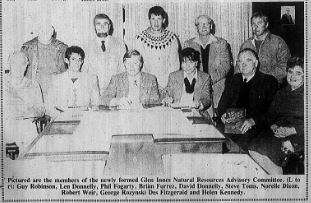
GLENRAC Celebrates 30 Years!
On the 22nd June 1989, the first official meeting of the Glen Innes Natural Resources Advisory Committee took place at the Glen Innes Town Hall. Formed with an 11-person board, the group had come together to investigate a total catchment management plan for the Macintyre Valley, and to take action against the crippling effects of eucalypt dieback gripping the region at the time.
“The ecological health of the landscape around Glen Innes was facing a bleak future in the late 80s, due to significant soil degradation from inappropriate tree clearing and the effects of New England Dieback,” says GLENRAC founding member, Desmond Fitz Gerald. “One of the committee aims was to petition the government to provide funding for the development of regeneration programs, such as tree planting and soil rejuvenation, and to educate the wider community about the importance of nutrient rich landscapes.”
Cr. Steve Toms was also a member of the first GLENRAC board, and wishes to acknowledge the efforts of the founding committee, in particular the late Phil Fogarty, who was working as the Glen Innes District Soil Conservationist at the time, in establishing a community based environmental group during an era when few others existed.
“GLENRAC was founded on the support of fantastic and enthusiastic volunteers, and the backing of local sponsors,” says Cr. Toms. “Seeing the enthusiasm and vision of the founding members evolve over the last thirty years into the well-structured, respected, self-sustaining organisation that GLENRAC has become is quite incredible. GLENRAC has been, and continues to be, a voice and facilitator, bringing rural people together with a common interest in sustainable agriculture.”
Today, GLENRAC is recognised as a Landcare leader across NSW, winning the 2015 NSW Landcare Group award and being a finalist at the 2017 National Landcare Awards. The organisation has expanded significantly since it was first founded thirty years ago – GLENRAC now has over 800 members, ten community groups, seven part-time staff and a board made up of local community volunteers, including landholders and members representing government and non-government organisations, who champion the issues affecting people living in the Glen Innes region.
GLENRAC’s overall mission is to provide solutions for sustainable and productive landscapes, and this is achieved through a number of projects, events and field days, delivered to the community across the areas of: natural resource management, native revegetation of degraded landscapes and ecosystems, control of feral animals and pest management, sustainable agriculture practices and community capacity building.
One of the primary strengths of GLENRAC over the years has been its ability to match funding applications with the needs of the Glen Innes community. Examples of this have included tree planting and erosion control initiatives, women in agriculture events, men’s mental health support, capacity building projects, feral animal management, and, most recently, the Australian Government Drought Communities Program, which has been instrumental in delivering activities, information and support to those in the region affected by drought conditions.
“GLENRAC has evolved over its thirty years to not only foster revegetation, but to bring together those with knowledge to share with those with an eagerness to improve their land management skills,” says GLENRAC Chairman, John Bavea. “GLENRAC recognises that a healthy productive landscape requires a healthy productive community to manage it. In this ever-changing contemporary environment, the skills required become more challenging, and in many respects, more satisfying for those land managers who can succeed.
“We at GLENRAC take a holistic approach in our mission of achieving a great place to live and a great country to live in. GLENRAC loves what it does, and the community that it has become an integral part of. For those who are involved, it is enormously satisfying and that satisfaction comes from the people that we help.”




